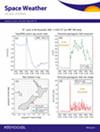Statistical Characteristics of Total Electron Content Intensifications on Global Ionospheric Maps
IF 3.7
2区 地球科学
引用次数: 0
Abstract
Global ionospheric total electron content (TEC) maps exhibit TEC intensifications and depletions of various sizes and shapes. Characterizing key features on TEC maps and understanding their dynamic coupling with external drivers can significantly benefit space weather forecasting. However, comprehensive analysis of ionospheric structuring over decades of TEC maps is currently lacking due to large data volume. We develop feature extraction software based on image processing techniques to extract TEC intensification regions, that is, contiguous regions with sufficiently elevated TEC values than surrounding areas, from global TEC maps. Applying the software to the Jet Propulsion Laboratory Global Ionospheric Map data, we generate a TEC intensification data set for years 2003–2022 and carry out a statistical study on the number and strength of TEC intensifications. We find that the majority of the TEC maps (about 86%) are characterized with one or two intensification(s), while the rest of the TEC maps have three or more intensifications. Both the number and strength of TEC intensifications exhibit semi-annual variation that peaks near equinoxes and dips near solstices, as well as an annual asymmetry with larger values around December solstice compared to June solstice. The number and strength of intensifications increase with enhanced solar extreme-violet irradiance. The strength of intensifications also increases with elevated geomagnetic activity, but the number of intensifications does not. In addition, the number of intensifications is not correlated with the strength of intensifications.全球电离层地图上总电子含量强化的统计特征
全球电离层电子总含量(TEC)图显示了各种规模和形状的 TEC 强化和衰减。描述 TEC 地图上的关键特征并了解其与外部驱动因素的动态耦合,可大大有益于空间天气预报。然而,由于数据量庞大,目前还缺乏对数十年 TEC 地图上电离层结构的全面分析。我们开发了基于图像处理技术的特征提取软件,以从全球 TEC 地图中提取 TEC 强化区域,即 TEC 值比周围区域高出足够多的毗连区域。将该软件应用于喷气推进实验室全球电离层地图数据,我们生成了 2003-2022 年的 TEC 强化数据集,并对 TEC 强化的数量和强度进行了统计研究。我们发现大多数 TEC 地图(约 86%)都有一个或两个增强,而其余的 TEC 地图则有三个或更多增强。TEC 强化的数量和强度都呈现出半年变化,在春分附近达到峰值,在夏至附近下降。随着太阳极紫外辐照度的增强,增强的次数和强度都会增加。增强的强度也会随着地磁活动的增强而增加,但增强的次数不会增加。此外,加强的次数与加强的强度也不相关。
本文章由计算机程序翻译,如有差异,请以英文原文为准。
求助全文
约1分钟内获得全文
求助全文

 求助内容:
求助内容: 应助结果提醒方式:
应助结果提醒方式:


